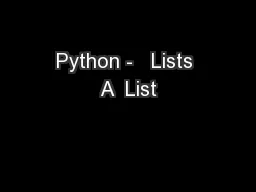PPT-List comprehensions
Author : briana-ranney | Published Date : 2017-09-18
and other shortcuts UW CSE 160 Winter 2017 Three Ways to Define a List Explicitly write out the whole thing squares 0 1 4 9 16 25 36 49 64 81 100 Write a
Presentation Embed Code
Download Presentation
Download Presentation The PPT/PDF document "List comprehensions" is the property of its rightful owner. Permission is granted to download and print the materials on this website for personal, non-commercial use only, and to display it on your personal computer provided you do not modify the materials and that you retain all copyright notices contained in the materials. By downloading content from our website, you accept the terms of this agreement.
List comprehensions: Transcript
Download Rules Of Document
"List comprehensions"The content belongs to its owner. You may download and print it for personal use, without modification, and keep all copyright notices. By downloading, you agree to these terms.
Related Documents














